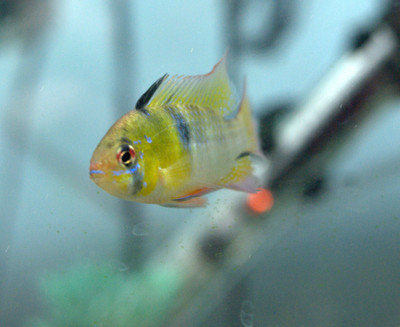German Blue Ram
Posted by Max Gandara on on 2nd Jan 2024
The Blue Ram Cichlid, scientifically known as Mikrogeophagus
ramirezi, belongs to the Cichlidae family. Originating from South
America, particularly the Orinoco River basin, these cichlids are known
for their vibrant colors and unique markings. As dwarf cichlids, they
have a compact size and a peaceful disposition, making them suitable for
community aquariums. The genome of German Blue Rams aligns with that of
other cichlids, and their evolutionary line involves adaptations to the
diverse aquatic environments of their native habitat.
Summary of Aquatic Life:
German Blue Ram Cichlids are prized for their striking blue and gold
coloration and distinctive markings. They are characterized by their
laterally compressed bodies and extended dorsal fins. As social fish,
they prefer aquariums with stable water conditions and ample hiding
spots. Their diet includes high-quality pellets, live or frozen foods
like brine shrimp and bloodworms, and occasional vegetable matter.
German Blue Rams thrive in planted tanks with soft, acidic water.
Creating a Happy and Healthy Environment:
1. Tank Size: Provide a tank of at least 20 gallons with a stable and secure lid.
2. Water Parameters: Maintain a temperature between 78-85°F (25-29°C) and a pH level between 6.0-7.5.
3. Filtration: Efficient filtration to ensure clean and well-oxygenated water.
4. Substrate and Decor: Use fine substrate and include plants, driftwood, and caves for hiding places.
5. Lighting: Use subdued lighting to replicate their natural habitat.
6. Feeding: Offer a varied diet including high-quality cichlid
pellets, live or frozen foods, and occasional vegetable matter.
Compatible Aquatic Life:
Fish:
1. Bolivian Ram Cichlid (Mikrogeophagus altispinosus): Similar in size and temperament, creating a harmonious community.
2. Apistogramma (Apistogramma spp.): Dwarf cichlids suitable for a peaceful community tank.
3. Cardinal Tetra (Paracheirodon axelrodi): Small, colorful tetras compatible with German Blue Rams.
4. Corydoras Catfish (Corydoras spp.): Bottom-dwelling catfish that coexist well with dwarf cichlids.
5. Kuhli Loach (Pangio kuhlii): Peaceful, eel-like loaches suitable for a community setup.
Crustaceans:
1. Amano Shrimp (Caridina multidentata): Non-aggressive shrimp suitable for larger setups.
2. Red Cherry Shrimp (Neocaridina davidi): Colorful and compatible with German Blue Rams.
3. Ghost Shrimp (Palaemonetes spp.): Inexpensive and harmless tank cleaners.
4. Bamboo Shrimp (Atyopsis moluccensis): Larger filter-feeding shrimp suitable for larger tanks.
5. Vampire Shrimp (Atya gabonensis): Peaceful filter-feeding shrimp.
Bugs:
1. Daphnia: Nutrient-rich live food for German Blue Rams.
2. Mosquito Larvae: Natural and occasional live food.
3. Fruit Flies: Small, flying insects for variety in the diet.
4. Bloodworms: High-protein live or frozen food.
5. Brine Shrimp: Excellent for conditioning and variety in diet.
Plants:
1. Java Moss (Taxiphyllum barbieri): Provides hiding spots and breeding grounds.
2. Anubias (Anubias spp.): Attachable to driftwood, providing cover for German Blue Rams.
3. Cryptocoryne (Cryptocoryne spp.): Rooted plants adding to the overall habitat.
4. Amazon Sword (Echinodorus amazonicus): Larger plants suitable for spacious tanks.
5. Vallisneria (Vallisneria spp.): Tall, grass-like plants for the background.
Amphibians:
1. Dwarf African Clawed Frog (Hymenochirus spp.): Peaceful aquatic frogs.
2. African Dwarf Frog (Hymenochirus curtipes): Small, aquatic frogs compatible with German Blue Rams.
3. Fire-Bellied Newt (Cynops spp.): Semi-aquatic newts suitable for a shared habitat.
4. Oriental Fire-Bellied Toad (Bombina orientalis): Colorful toads for a unique aquatic setup.
5. Mudskipper: Brackish water amphibian, providing a dynamic ecosystem.
These considerations contribute to a diverse and balanced aquatic
community, ensuring the well-being of German Blue Ram Cichlids and their
tankmates.

